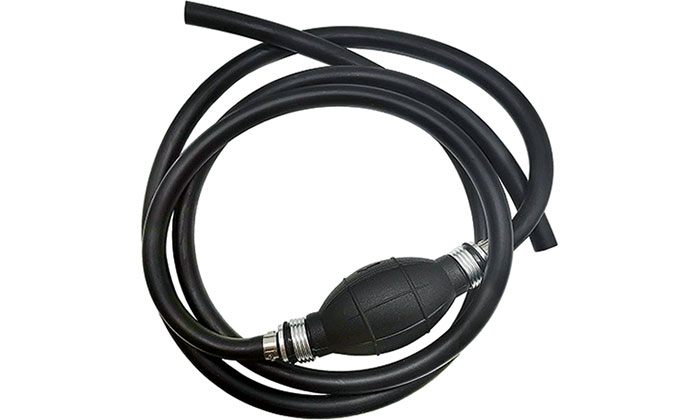Advertisement
You might think softening up that old primer bulb will save you a few pennies, but doing so is false economy at best.

There are different types of gasoline primer bulbs, all of which contain various types of valves inside. Sometimes these bulbs become so hard it's difficult to squeeze them; sometimes even though you can squeeze them, they pump poorly, if at all.
Hard or stiff bulbs (and lines) are a sign of aging and possible deterioration. Pumps having to do with gasoline and fuel lines (especially if you use gas with ethanol) should be in excellent condition and not aged. Even if you don't experience a leak of liquid, there could be leakage of fumes.
But there's more than just the issue of fuel or fumes escaping from the line or bulb. That deteriorated material inside the line or bulb could enter your fuel flow, or simply stop that flow and/or migrate to your engine and interfere with its operation. Also, if your bulb is hard to squeeze, the one-way valves inside the bulb (there are usually two, one at each end) are probably deteriorated — or worse — so the bulb pump won't work or would work poorly. They could also be stuck from junk in the fuel.
In a typical valve, the balls are held in position against the surrounding housing seal by springs. These are, by design, one-way valves. There is a downstream valve for the downstream flow and an upstream valve that allows fuel to flow from the tank into the bulb but won't permit back flow. It's important to have the bulb oriented properly.
On the bulb, you should see an arrow pointing in the direction of the fuel flow. When you squeeze the bulb, the downstream valve opens from the pressure, allowing its fuel to release into the downstream part of the line, and the other upstream valve seals against back flow to keep it from backing up into the upstream part of the fuel line.
When you release the bulb, the upstream valve opens, allowing fuel to flow from the tank into the vacuum created within the bulb by your releasing the bulb; the downstream one closes, thus allowing the suction into the bulb. Poor sealing, leaking, or simple stiffness can be a problem, and with enough use, the springs may become impaired.

An outboard fuel primer assembly makes transferring fuel from a supply tank to portable tank easy — not to mention that it's much safer than creating suction with your mouth!
Sometimes orienting the bulb so that gravity helps the operation of the valves and the flow can get temporary relief, but this isn't really the best thing to do except in emergencies. Sometimes placing a finger over one end of the line will temporarily force valve operation. But these "fixes" are seldom the best way to go. You're hoping to avoid explosions, fire, gasoline leaks, or poorly performing motors — serious business!
Over the years I've noticed that pump bulbs have gotten fairly expensive, as have the bulb and fuel line kits that are sometimes sold together. But these are critical parts of the system, and when the old ones quit or become impaired, it's worth spending the money to buy the best new bulbs that are fully in accord with manufacturer specs and any applicable ABYC standards. Get them as part of a fuel-line set, or as separate bulbs if you're confident the rest of your line is good.
One final note: These pumps and attached hoses make handy fuel-transfer devices. I've used them to get fuel flowing in a detached hose to set up a siphon from a supply tank to a portable tank. This sure beats what I've heard some people do — suck on the downstream end of the hose and try to time it just right so that they stick the hose into the receiving can before getting a mouthful of fuel. Never, ever do this! It's unbelievably dangerous.
